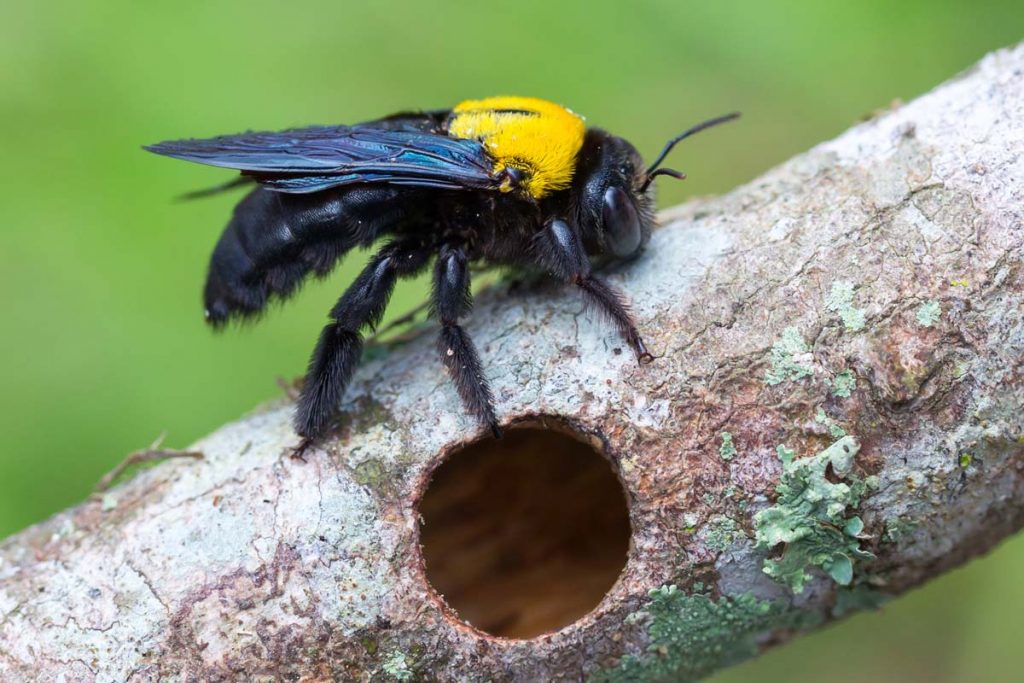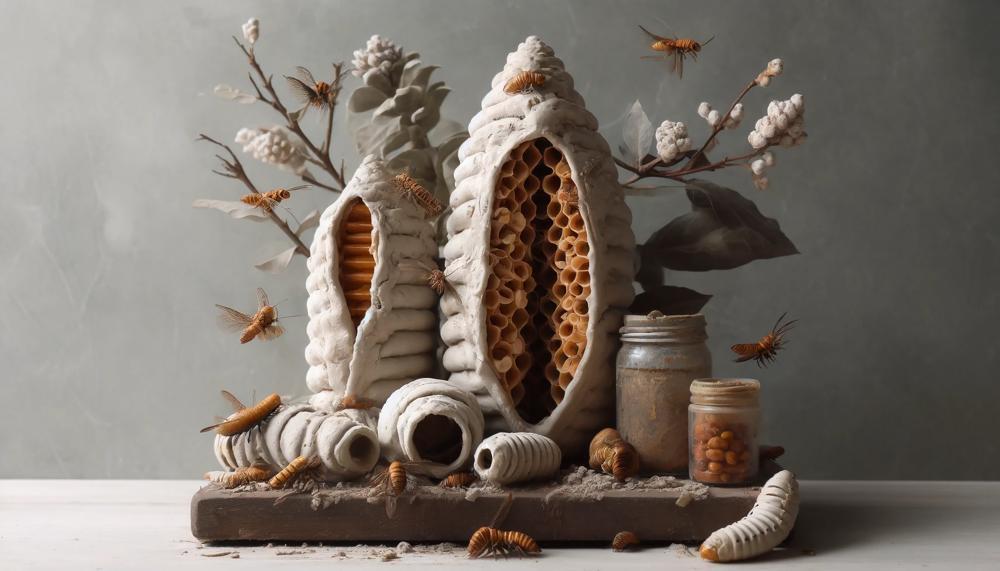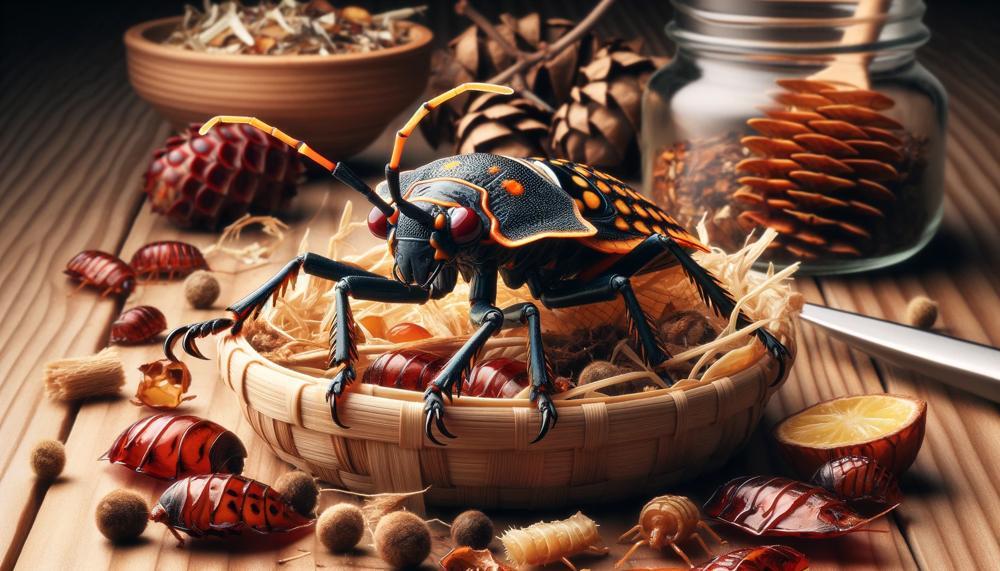Tired of watching your wooden structures crumble under the relentless attack of carpenter bees?
These buzzing insects may seem harmless, but their incessant drilling and nesting can wreak havoc on your property. But don’t fret, because we’ve got you covered with effective methods for eliminating carpenter bees and preventing future infestations.
In this blog post, we’ll dive into everything you need to know about getting rid of these wood-boring pests, including their pesky behaviors and habits, common signs of an infestation, natural and chemical solutions for elimination, and tips for keeping them away for good. Say goodbye to the headache of dealing with carpenter bees and hello to a bee-free home.
So, keep reading to discover how you can bid farewell to these bothersome bugs once and for all.
Table of Contents
- 1 How To Get Rid Of Carpenter Bees?
- 2 The Differences Between Carpenter Bees and Bumblebees: How to Identify Them
- 3 Prevention is Key: How to Keep Carpenter Bees Away From Your Home
- 4 Protecting Your Property: Tips for Treating Exposed Wood to Deter Carpenter Bees
- 5 Targeted Treatments: Using Insecticides and Natural Remedies to Eliminate Carpenter Bees
- 6 The Importance of Relocation: Alternatives to Killing Carpenter Bees
- 7 Handling Insecticides with Caution: Safety Measures When Dealing with Pest Control
- 8 Conclusion
How To Get Rid Of Carpenter Bees?
It is crucial to take preventative measures
Inspect your home for any openings or gaps, and seal them with caulk or steel wool. Additionally, consider painting or varnishing any exposed wood to make it less appealing to carpenter bees.
Utilize targeted methods
Residual insecticide sprays and dust insecticides can be directly applied into nest holes to exterminate carpenter bees.
Explore natural remedies
Essential oils such as peppermint, tea tree, and eucalyptus can be combined with water and sprayed around potential entry points to repel carpenter bees.
Consider relocation as an alternative
Instead of resorting to killing the bees, try setting up a bee house or providing alternative nesting materials to relocate them.
Seek professional assistance
If the infestation is severe, it is best to seek professional pest control services for safe and effective removal of carpenter bees.
| Technique | How it Functions | Benefits | Drawbacks |
| Prevention | Sealing entry points and treating exposed wood deters carpenter bees from nesting in your home. | Eco-friendly, cost-effective. | May not be effective if infestation has already occurred. |
| Targeted Methods | Insecticides can be directly applied into nest holes to eliminate carpenter bees. | Efficient at eradicating infestations. | Can be hazardous if not used correctly. |
| Natural Remedies | Essential oils can repel carpenter bees when sprayed around entry points. | Natural and harmless for humans and pets. | May not completely eliminate infestation. |
| Relocation | Setting up a bee house or providing alternative nesting materials can relocate the bees instead of killing them. | Eco-friendly, preserves beneficial pollinators. | May not be practical for extensive infestations. |
| Professional Pest Control | Experienced professionals can safely and effectively remove carpenter bees from your home. | Ensures complete elimination of infestation. | Can be costly and may require multiple treatments. |
Preventing carpenter bee infestations is critical. Inspect your home for any openings or gaps, and seal them with caulk or steel wool. Consider painting or varnishing any exposed wood to make it less appealing to carpenter bees.
The Differences Between Carpenter Bees and Bumblebees: How to Identify Them
These variations encompass size, color, flight maneuvers, nesting behaviors, and levels of aggression. Being aware of these distinctions can aid in accurately identifying and differentiating between the two species, empowering homeowners to take appropriate steps for controlling pests.
One noticeable difference between carpenter bees and bumblebees is their size. While carpenter bees are significantly larger than bumblebees, measuring up to an inch in length, bumblebees are comparatively smaller at only half an inch. Additionally, their coloration also differs. Carpenter bees have a shiny black body with a yellow thorax, while bumblebees have a fuzzy black and yellow body.
In terms of flight patterns, carpenter bees tend to fly in a straight line while bumblebees have a more erratic flight path. This difference can be observed when watching them pollinate flowers or hovering around their nest entrance. Speaking of nests, another distinguishing factor is the nesting habits of these two bee species. Carpenter bees prefer to excavate tunnels in wood structures while bumblebees build their nests in the ground.
Last but not least, aggression levels are another aspect that sets carpenter bees and bumblebees apart. Carpenter bees are known to be more territorial and aggressive when defending their nests compared to bumblebees. This is because carpenter bees do not live in colonies like bumblebees and therefore have a stronger attachment to their individual nests.
By understanding these differences between carpenter bees and bumblebees, homeowners can accurately identify which species they are dealing with and take appropriate measures for pest management.
Prevention is Key: How to Keep Carpenter Bees Away From Your Home
-
- Utilize Insecticides: One of the most effective ways to prevent carpenter bees is by utilizing insecticides. These can be sprayed around your home to eliminate existing bees and discourage new ones from nesting. Look for insecticides specifically designed for carpenter bees, as they will be more potent.
- Seal Holes in Wood: Carpenter bees prefer to nest in untreated wood with pre-existing holes. To deter them from making their home in your wooden structures, seal any holes with plugs, putty, or caulk. This will also aid in keeping out other pests.
- Coat Wooden Surfaces: Carpenter bees are attracted to bare wood, so coating outdoor wooden surfaces can act as a deterrent. The impenetrable barrier created by the coating makes it difficult for the bees to drill into the wood.
- Avoid Noise and Vibrations: Carpenter bees are sensitive to noise and vibrations, so try to minimize these near their nesting areas. This means avoiding loud activities such as drilling or hammering near their nests.
- Use Natural Repellents: There are certain natural repellents that can help keep carpenter bees away from your home. These include essential oils like citronella, peppermint, and eucalyptus, as well as herbs like basil, mint, and thyme. You can sprinkle these around your home or make a spray to repel the bees.
- Install Bee Traps: Commercial bee traps are available that can effectively catch carpenter bees. These traps mimic the appearance of a nest and attract the bees into them. Once inside, they cannot escape and eventually die.
- Maintain Clean Surrounding Areas: Keeping your yard and surrounding areas clean and free of debris can also aid in preventing carpenter bees. They are less likely to nest in an area that is well-maintained and free of clutter.
- Use Physical Barriers: Physical barriers such as screens, mesh, or tar paper can be used to cover potential nesting sites and prevent carpenter bees from accessing them.
- Plant Bee-Repelling Flora: There are certain plants that naturally repel bees, such as marigolds, geraniums, and mint. Planting these around your home can help keep carpenter bees away.
- Regular Maintenance: Regularly inspecting and maintaining your home’s exterior can also aid in preventing carpenter bees.
Protecting Your Property: Tips for Treating Exposed Wood to Deter Carpenter Bees
The protection of your property from the destructive habits of carpenter bees is a top priority. In order to effectively treat exposed wood and deter these pesky insects, consider following these tips:
Seal any potential entry points
It is crucial to thoroughly inspect the exterior of your home for any holes or gaps that could serve as entryways for carpenter bees. By sealing these openings with caulk or steel wool, you can prevent them from establishing nests inside of your home.
Add a protective layer
Carpenter bees are particularly drawn to untreated and unpainted wood. By adding a layer of paint or varnish, you can deter them from boring into the wood. Consider using pressure-treated or synthetic wood for any outdoor structures.
Utilize targeted insecticides
In order to eliminate existing carpenter bee infestations, targeted insecticides like residual sprays and dust can be applied directly into their holes and tunnels.
Try natural remedies
Essential oils such as peppermint, tea tree, and eucalyptus are known to repel carpenter bees. Create a mixture by combining a few drops with water and spray it around potential entry points or directly onto the wood.
Relocate the bees
If possible, it is always better to relocate the bees rather than killing them. Consider setting up a bee house or providing alternative nesting materials for them to use instead.
By implementing these strategies, you can successfully treat exposed wood and discourage carpenter bees from causing damage to your property.
Targeted Treatments: Using Insecticides and Natural Remedies to Eliminate Carpenter Bees
Carpenter bees can be a pesky nuisance, causing damage to wooden structures and posing a threat to humans and pets. Fortunately, there are a variety of effective options for eliminating these buzzing intruders.
Insecticides such as carbaryl, deltamethrin, bifenthrin, cyfluthrin, and permethrin are some of the most powerful tools in the battle against carpenter bees. These chemicals target the nervous system of the bees, causing paralysis and ultimately leading to their demise.
For those seeking a more natural approach, citrus oils like lemon or orange oil can also be effective in getting rid of carpenter bees. Diatomaceous earth (DE) is another popular choice as it is harmless to humans but lethal for insects like carpenter bees. Other natural remedies include using a combination of vinegar and water, cayenne pepper spray, and strategically placed bee traps.
When selecting an insecticide or natural remedy, it is crucial to take into consideration the safety of humans, pets, and other beneficial insects such as bees and butterflies. It is also essential to follow instructions closely and consistently for optimal results.
For a more comprehensive approach, combining different methods may be beneficial. This can include sealing entry points and applying a protective layer on wood to prevent carpenter bees from returning while utilizing insecticides or natural remedies to eliminate any existing bees.
So, there are various effective options for getting rid of carpenter bees. It is crucial to choose a method that aligns with your preferences and needs while prioritizing the safety of people and other insects.
The Importance of Relocation: Alternatives to Killing Carpenter Bees
Instead of resorting to harmful chemicals or destructive methods, capturing and releasing these valuable pollinators into a more suitable habitat allows us to maintain the delicate balance of nature and preserve the ecosystem.
Not only does this method avoid any potential damage to wooden structures caused by carpenter bees, but it also eliminates the need for toxic substances. Moreover, relocation can ultimately save homeowners money in the long run and contribute to the preservation of biodiversity.
Carpenter bees are vital members of our ecosystem, serving as important pollinators for a variety of plants and flowers. However, their habit of drilling holes into wooden structures can be a nuisance for homeowners. In the past, killing these bees was often seen as the only solution. But with relocation, we can take a more compassionate and sustainable approach.
By carefully capturing and releasing carpenter bees into a more suitable environment, we not only preserve their role in nature but also avoid any potential harm that could be caused by chemical insecticides. This method also reduces the risk of damage to wooden structures, saving homeowners from costly repairs and preserving the natural beauty of their homes.
In addition to its positive impact on the environment, relocation also has economic benefits. By avoiding the use of harmful chemicals and minimizing potential damage, homeowners can save money in the long run.
And by preserving biodiversity through relocation, we ensure the continued health and vitality of our ecosystem for generations to come.
Handling Insecticides with Caution: Safety Measures When Dealing with Pest Control
When dealing with pest control, it is crucial to handle insecticides with caution and take necessary safety measures to ensure the protection of yourself and the environment. This is particularly important when attempting to eradicate carpenter bees, as they play a vital role as pollinators and should be relocated instead. However, if the use of insecticides cannot be avoided, here are some precautionary measures that should be taken:
- Wear appropriate protective gear: It is essential to wear personal protective equipment (PPE), including long-sleeved shirts, long pants, gloves, rubber footwear, goggles, and dust mist filters while handling pesticides. This will effectively shield your skin and eyes from any potential exposure.
- Cover exposed skin: Skin exposure is the most common way for pesticides to enter the body. To lower this risk, cover as much of your skin as possible with clothing.
- Use original labeled containers: Do not transfer pesticides into unlabeled or food containers. Keep them in their original labeled containers to avoid confusion and accidental ingestion.
- Properly handle spills: In case of any spills, do not rinse them off but use sawdust or kitty litter to absorb them. Dispose of them properly according to the label instructions.
- Clean up thoroughly: After using pesticides, make sure to clean up thoroughly by washing your hands and any exposed skin with soap and water. Also, clean any equipment used for handling pesticides.
- Avoid excessive use: It is crucial not to exceed the recommended amount of pesticide usage as it can be harmful to the environment and illegal.
By adhering to these safety measures, you can effectively use insecticides for pest control without risking harm to yourself or the environment. However, it is essential to assess the effectiveness of pesticide use and consider alternative methods, such as relocation, before resorting to chemical solutions.
Conclusion
In conclusion, dealing with carpenter bees can be a frustrating and destructive experience. But fear not, for there are effective methods to eliminate these wood-boring pests and prevent future infestations. From preventative measures to targeted treatments and natural remedies, homeowners have a plethora of options at their disposal.
It is crucial to understand the differences between carpenter bees and bumblebees, as well as the importance of relocation as an alternative to extermination.
When using insecticides, it is imperative to handle them with caution and take necessary safety measures to protect yourself and the environment. By implementing these strategies, you can bid farewell to carpenter bees and once again enjoy a bee-free abode.





